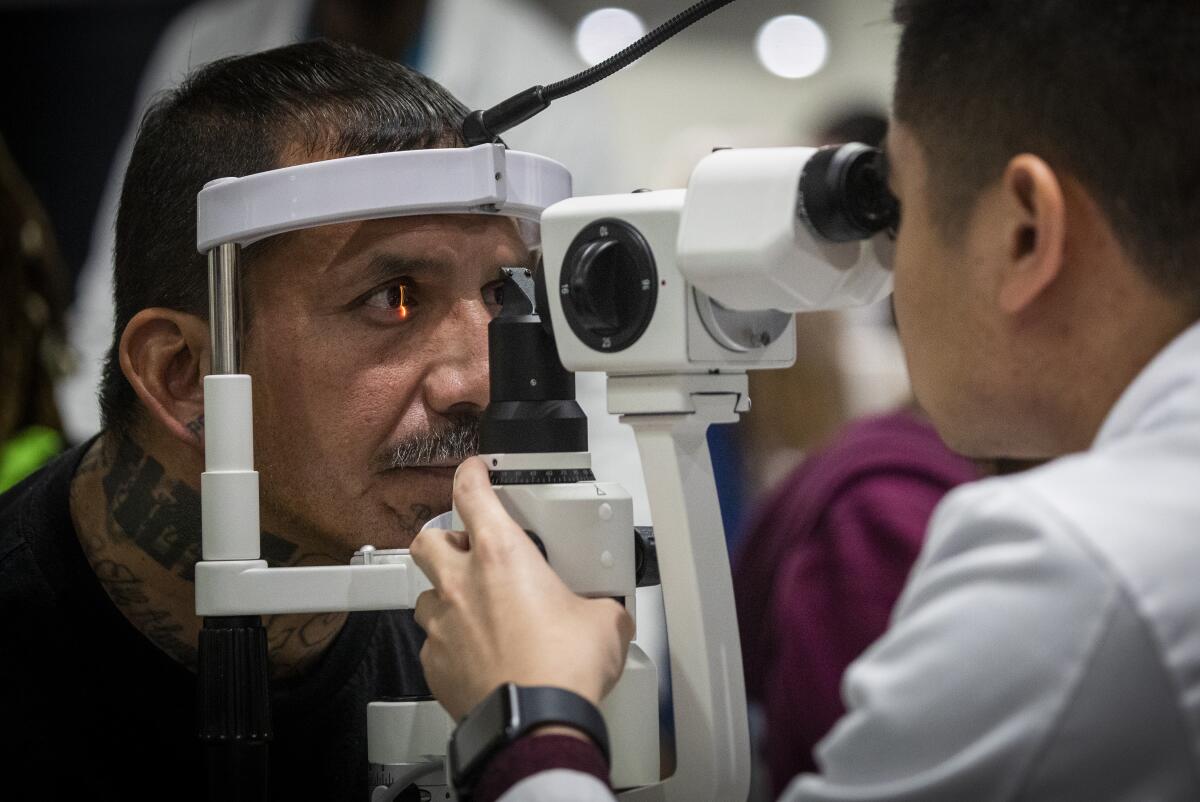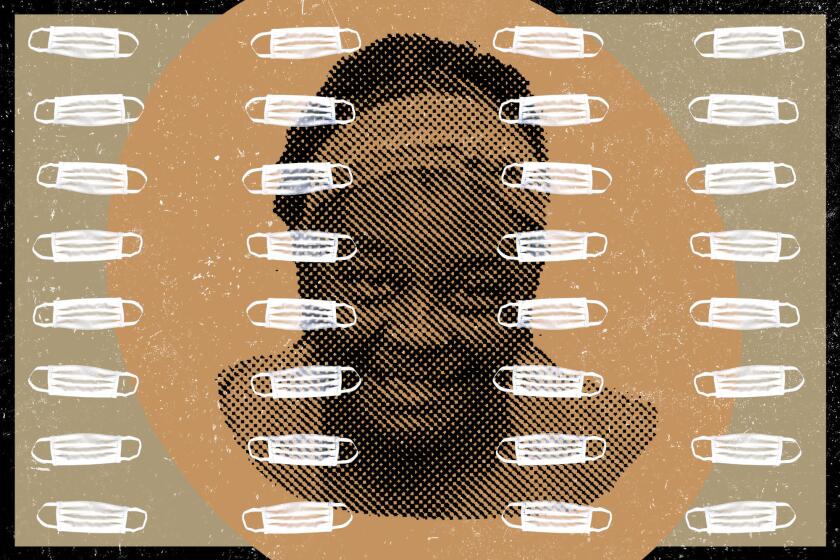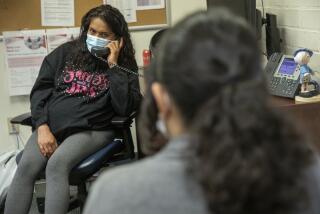Medi-Cal relies on prison-made eyeglasses. Are delays and defects worth the cost?

To dodge hefty costs for eyewear, California’s health insurance program for low-income people, Medi-Cal, has an innovative strategy: It contracts exclusively with the state’s prisons, and inmates make glasses for its beneficiaries.
But the partnership that began more than 30 years ago has fractured. Medi-Cal enrollees, many of whom are children, and their eye-care providers say that they often wait months for the glasses and that sometimes they arrive broken.
“I understand the aim of trying to give prisoners a worthy occupation,” said Kelly Hardy, senior managing director of health and research for a California-based child advocacy group, Children Now. “But not at the expense of kids being able to see.”
Medi-Cal’s contract with the California Prison Industry Authority, or CALPIA, a business enterprise within the California Department of Corrections and Rehabilitation that employs inmates, has been in place since 1988. Other Medicaid programs — including those in Massachusetts and North Carolina — rely on prison labor to fulfill the promises of their vision benefit.
Experts noted, though, that such innovations work only if patients receive their glasses in a timely manner. Complaints from consumers and eye professionals have led California lawmakers to consider an expensive proposal that would allow Medi-Cal to purchase glasses from retail labs.
San Francisco resident Jane Angel said her 6-year-old son, David Morando, waited two months for his glasses to be delivered. He needed them because “he sits in the back of his classroom,” Angel said. She’s concerned because David is also on the autism spectrum, so not being able to see is another reason that concentrating in class is hard for him. “He’s not able to see the board, and it’s just hard for him to learn,” Angel said.
Optometrists, too, have been frustrated by slow turnaround times and frequent prescription mistakes.
“There’s nothing that we can do to get the glasses quicker,” said Joy Grey, the office manager of Alpert Eye Care in Mission Viejo. Her clinic tracks pending glasses orders by keeping empty trays for each on a shelf. A few months ago, so many CALPIA orders were pending that Grey and her colleagues were running out of space for others. “That’s how backlogged we are,” she said.
A third of Californians — including 40% of the state’s children, nearly 5.2 million kids — are enrolled in Medi-Cal. The federal government requires that Medicaid offer vision benefits for children. Medi-Cal has generally covered routine eye exams and a pair of glasses once every two years for this age group. In January 2020, California’s program expanded benefits to adults.
Orders for glasses from Medi-Cal to CALPIA rose from nearly 490,000 in 2019 to 654,000 in 2020 and then to 880,400 in 2021.
Medi-Cal pays CALPIA about $19.60 for every pair of glasses made, said Katharine Weir-Ebster, a spokesperson for the California Department of Health Care Services.
In an unscientific survey of 171 of its members in March, the California Optometric Assn. found that 65% of respondents had experienced waits of one to three months for glasses ordered for Medi-Cal patients. In comparison, the survey found that the average turnaround time for glasses from private labs was less than 15 days.
But CALPIA spokesperson Michele Kane said production has been moving much faster than that. She said orders from 2011 to 2020 were filled, on average, five days after labs received them, but turnaround times began to slip during the COVID-19 pandemic and hit a peak in January 2021 with a 37-day average.
Since then, she said, the wait times for orders have improved. They reached nine days by April 2021 and are expected to get back to five days this month.
Inmates who made masks and furniture for as little as 35 cents an hour say they felt pressure to stay on the job, even as the coronavirus spread through the prison factories.
To speed up fulfillment of Medi-Cal glasses orders, Kane said, CALPIA contracts with nine “backup” labs. Five are in states outside California. Of the 880,400 orders the prison authority received last year, 54% were sent to the contracted private labs, Kane said. These labs send the glasses to CALPIA, which then mails them to the clinics that ordered them.
Kane blamed prison lockdowns and restrictions triggered by the COVID-19 pandemic for exacerbating what she said were previously system hiccups that could upend production in prison optical labs.
In the survey, however, more than half the optometrists said they had not seen turnaround times improve significantly.
A bill under consideration by the California Legislature seeks to address the issue by stripping away the exclusivity of the arrangement and allowing clinics to also order glasses from retail labs.
The measure is a “response to the shocking disparity in the level of optical care that the state provides to some of its most vulnerable residents,” state Sen. Scott Wilk (R-Santa Clarita), the bill’s sponsor, said in a written statement.
But it has a big price tag. An analysis by California’s Department of Health Care Services, which was referenced by lawmakers supporting the bill, estimates that the cost to Medi-Cal for a pair of glasses from private labs would be 141% higher than what it pays CALPIA.
CALPIA employs 295 incarcerated people for optical programs in three prisons: Valley State Prison in Chowchilla; the California State Prison Solano in Vacaville; and, most recently, the Central California Women’s Facility in Chowchilla. When the optometric program at the women’s facility is in full operation, expected this month, that total will be 420.
One benefit of the partnership is that inmates learn skills they can use to get jobs after they complete their sentences. It also works to lower recidivism rates, Kane said.
Anthony Martinez, 40, knows the pros and cons of the system. He was incarcerated in 2000 at age 19. For the last three years of his decadelong sentence, he worked in the prison’s optical program. “That was an opportunity that I was going to take full advantage of,” Martinez said.
The day after his release, Martinez got a license from the American Board of Opticianry to manufacture and sell glasses. A month later, he was hired as a lab technician at a LensCrafters in Los Angeles and was eventually promoted to lab manager. By 2020, he had helped open three other eyeglasses stores across the state.
Martinez is aware of the benefits he gained from his experience in CALPIA’s optical program but understands the impact that long wait times have on patients, especially kids.
“I would think that it needs to be run better,” Martinez said. “I mean, being out there, I understand you have to have quality and precision for this kind of work.”
Dr. Premilla Banwait, a pediatric optometrist at UC San Francisco, said that in addition to experiencing long turnaround times, she has received many glasses for Medi-Cal patients that were broken.
Kane said CALPIA must remake fewer than 1% of orders.
Clarice Waterfield, 64, who lives in Paso Robles, had trouble with her order.
Waterfield has diplopia, or double vision, and an astigmatism that causes her vision to be blurry. She’s a personal shopper for grocery delivery company Instacart, and without help seeing, she said, boxes of cereal and crackers blend together. Grocery store aisles become big, long blocks.
She got her glasses about six weeks after ordering them March 1. She eagerly put them on but found they weren’t the right prescription. They made her vision worse. “You could have held a stuffed animal or something right in front of my face, and all I could see was a big, blurry smear.”
The clinic had to return the glasses and reorder them. After another six weeks, Waterfield received the correct pair. But she remembers the frustration.
“I was like, ‘Are you kidding me?’” Waterfield recalled. “I’ve been waiting too long for these glasses, and now that I have them in my hands, I have to hand them back?”
This story was produced by KHN (Kaiser Health News), one of the three major operating programs at KFF (Kaiser Family Foundation).
More to Read
Sign up for Essential California
The most important California stories and recommendations in your inbox every morning.
You may occasionally receive promotional content from the Los Angeles Times.











